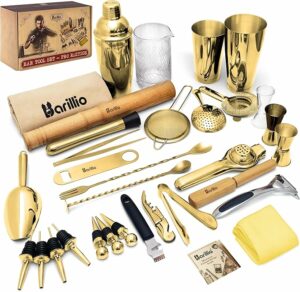I’m your host, KAD, and I’ve been slinging drinks and navigating the world of hospitality for over two decades.
The past two decades, I’ve perfected my bartending skills, experimented with countless flavour combinations, and learned a thing or two about how to keep the party going behind the bar.
Whether you’re a seasoned bartender like me just looking for some fresh inspiration or a complete beginner who is eager to whip up impressive cocktails at home, Shake, Sip, Serve is here to be your guide.
In the below blog, I’ll be sharing my knowledge and experience on everything from classic cocktails and innovative new creations to essential bartending techniques and industry secrets. I’ll also be offering tips on stocking your home bar, mastering the art of presentation, and creating a memorable experience for your guests.
So, grab your shaker, dust off your favourite glassware, and get ready to embark on a delicious journey into the world of bartending!
Let’s Shake, Sip, and Serve up something amazing together.
Disclaimer: This post contains affiliate links. If you purchase through these links, I may earn a small commission at no additional cost to you.
When I started my bartending career, I wanted nothing more than to create my own at-home bar so that I could share my love of cocktails at home with my friends and family.
I quickly discovered that creating a home bar was more than just adding bottles of liquor into a pre-purchased bar.
Once I started the journey to creating my own home bar space, I realised it needed to be a space that reflected my personality and gave me the freedom to explore the craft of mixology.
So remember whether you’re a fan of timeless classics or love experimenting with bold, modern flavours, your home bar should feel like an extension of your style.
In this guide, we’ll walk through how to plan your setup, the legal considerations to be aware of in Australia, the essential tools and spirits you’ll need, and the skills that will help you impress your guests.
Step 1: Define Your Style and Space
Before you rush out to buy a dozen bottles of spirits, ask yourself: what kind of bartender do I want to be at home?
- Classic enthusiast – If martinis, old fashioneds, and Negronis are your go-to, you’ll want a more traditional spirit selection and timeless glassware.
- Adventurous mixologist – If you enjoy experimenting with syrups, infusions, and native botanicals, you’ll need more tools, gadgets, and unique spirits.
- Social entertainer – If your goal is to host gatherings, you’ll want a setup that prioritises batching cocktails, plenty of seating, and easy-to-serve mixers.
Next, decide where your home bar will live. Some common options:
- A dedicated corner of the living room with a stylish bar cart.
- A kitchen bench extension for easy access while cooking and entertaining.
- A basement or patio setup for hosting larger groups.
- A back yard deck that gives the casual but social vibe.
Lighting, accessibility, and storage are key—your space should be functional and inviting, not cluttered.
Step 2: Understand the Legal Foundations
In Australia, enjoying alcohol at home is simple. But if you plan to serve it outside of personal use—say at a pop-up event, ticketed party, or “cash bar” setup—you must be aware of licensing laws.
- Personal use at home: You don’t need a licence to stock and serve alcohol in your own home to friends or family, provided no money changes hands.
- Selling alcohol (even casually): You’ll need a liquor licence under your state or territory’s legislation. For example, in NSW, this falls under the Liquor Act 2007, managed by Liquor & Gaming NSW. In Victoria, it’s regulated by the Liquor Control Reform Act 1998. Penalties apply for selling without a licence.
- RSA requirements: If you’re considering hospitality work or running events outside your home, you’ll need an RSA (Responsible Service of Alcohol) certificate. This ensures you’re trained to serve alcohol safely and responsibly.
Important!
Always check your state or territory’s liquor licensing website for the latest requirements. Even private events may fall under regulations if tickets are sold or alcohol is included in the cost.
References:
Step 3: Budgeting Your Home Bar
Building a home bar doesn’t need to break the bank. Start small and expand gradually:
- Essentials first – A few core spirits, basic bar tools, and versatile glassware.
- Gradual upgrades – Add premium bottles, unique mixers, and stylish decor as your budget allows.
- Smart shopping – Buy in bulk when hosting, and invest in quality tools that will last.
Think of it like building a wardrobe: start with basics that work for any occasion, then layer in specialty items over time.
Step 4: Must-Have Tools and Equipment
Your tools are what set you apart from a casual host. At a minimum, stock:
- Cocktail shaker – Boston or cobbler style.
- Jigger – For accurate measuring.
- Strainer – Hawthorne or fine mesh for silky cocktails.
- Muddler – For herbs, fruits, and spices.
- Mixing spoon – For stirring spirit-forward drinks.
- Ice molds/trays – Large cubes for slow-melting drinks.If you would like a recommendation, we suggest the Amazon Bartender starter kit. This kit contains every thing that you require to make all your at-home cocktails.
Glassware Essentials
- Martini or coupe glasses for classics.
- Rocks glasses for short cocktails.
- Highball glasses for tall drinks.
- Wine and champagne glasses if you’ll serve beyond cocktails.Check out the range of cocktail glassware on amazon for a mix of stylish glassware
Keep tools clean, polished, and well-stored—presentation is part of the experience.
Step 5: Stocking Your Spirits and Ingredients
Every home bar should start with a versatile “core” selection of spirits:
- Vodka – For martinis, Moscow mules, and infusions.
- Gin – Essential for Negronis, G&Ts, and martinis.
- Whiskey/Bourbon – Perfect for old fashioneds and sours.
- Rum – Needed for mojitos and daiquiris.
- Tequila/Mezcal – For margaritas and smoky twists.
Add Local Flavour
Australia’s craft spirit scene is booming. Brands like Four Pillars Gin (VIC), Archie Rose (NSW), and Lark Distilling Co. (TAS) bring native botanicals and world-class quality that make your cocktails uniquely Australian.
Don’t Forget the Backbone
- Mixers: soda, tonic, ginger beer, and cola.
- Fresh garnishes: citrus, herbs, seasonal fruit.
- Syrups and bitters: simple syrup, Angostura, flavoured bitters.
- Non-alcoholic options: seedlip, kombucha, or house-made cordials.
Step 6: Sharpening Your Mixology Skills
Building a bar is one thing; using it well is another. Here’s how to impress your guests:
- Master a signature cocktail – Whether it’s your spin on an espresso martini or a bush-inspired gin sour, create a drink that people associate with you.
- Nail the basics – Perfect classics like the Negroni, Mojito, or Old Fashioned before branching out.
- Focus on presentation – Garnishes, glass choice, and even the pour all add flair.
- Host interactive experiences – Invite guests to join in with cocktail demos or tasting flights.We have designed a beginner friendly downloadable Ebook that has 50 easy to follow cocktails. Get it here FREE..
Step 7: Keep Learning and Innovating
Mixology is a journey, not a destination. Stay sharp by:
- Attending local workshops or bartending courses.
- Following Australian mixologists on social media.
- Experimenting with seasonal and native ingredients.
- Exploring the growing trend of low- and no-alcohol cocktails.
Continuous learning ensures your home bar always feels fresh and exciting, while keeping you connected to Australia’s vibrant cocktail culture.
Final Pour
Building a home bar in Australia is about balancing passion with practicality. From understanding the legal basics and setting a realistic budget to sourcing local spirits and mastering your mixology skills, each step adds personality and purpose to your setup.
Whether you’re shaking martinis for two or batching punch for a party, your home bar should reflect who you are as a mixologist—and invite others to enjoy the journey with you.
The bartending community is a vibrant and supportive one, and I’m excited to build that community here on Shake, Sip, Serve.
I’d love to hear your thoughts, questions, and experiences in the comments below.
What are you shaking up these days?
What topics would you like to see covered in future posts?
Let’s connect and continue the conversation!
Liquor & Gaming NSW: This website provides information on liquor licensing, responsible service of alcohol (RSA) training, and regulations for serving alcohol in NSW. It’s essential for anyone working in the hospitality industry in NSW. You can find it here: https://www.liquorandgaming.nsw.gov.au/

